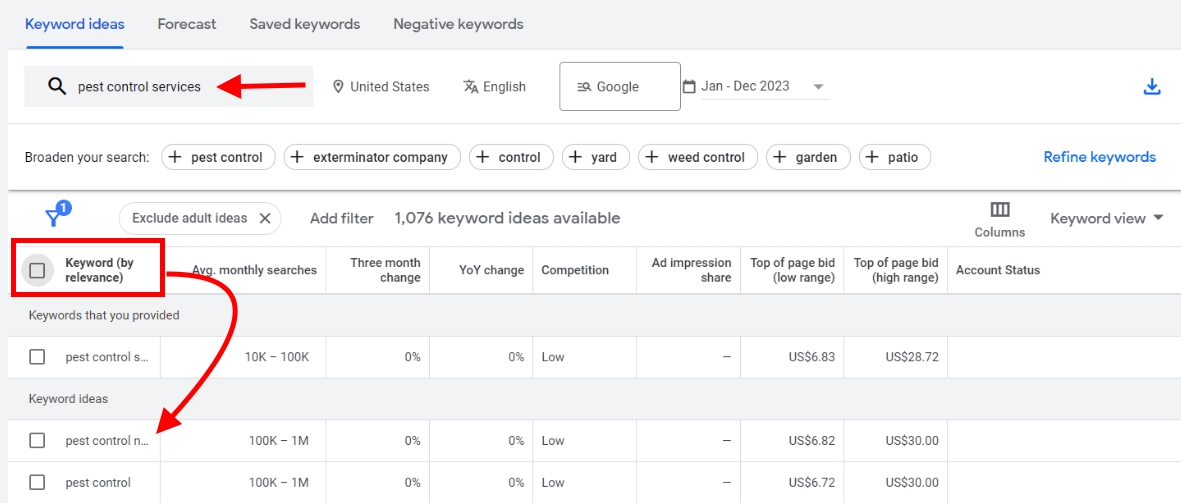Getting your website to show up for the right keywords is the basis of good SEO (Search Engine Optimization), but how do you know what keywords to target when you are just starting? And how do you rank for those keywords? That’s where the keyword research checklist comes into the picture.
Summary :
- What is Keyword Research?
- How to Conduct Keyword Research?
- Where to Use Researched Keywords on Your Website?
- Keyword Research Checklist for 2024
- Use Long Tail Keywords
- Select Keywords to Suit Your SEO or PPC Campaigns
- Assess the Search Engine Results Pages (SERP)
- Use Related Keyword Suggestions
- Pick Keywords Based on Your Audience’s Search Intent
- Strike a Balance Between Keyword Difficulty and Search Volume
- Target Location-based Keywords (If you sell products in a particular location)
- Use Conversational Keywords
- Perform Keyword Gap Analysis
In this ultimate keyword research checklist updated for 2024, we’ll tell you how to find opportunities to rank for keywords your customers search for, which keywords to target, and more.
What is Keyword Research?
The phrases or words people use while searching on search engines are called keywords. For example, in the image below, we typed the query “price of latest Apple watch.” This query is the keyword that people use to search to know the price of the latest Apple Watch.
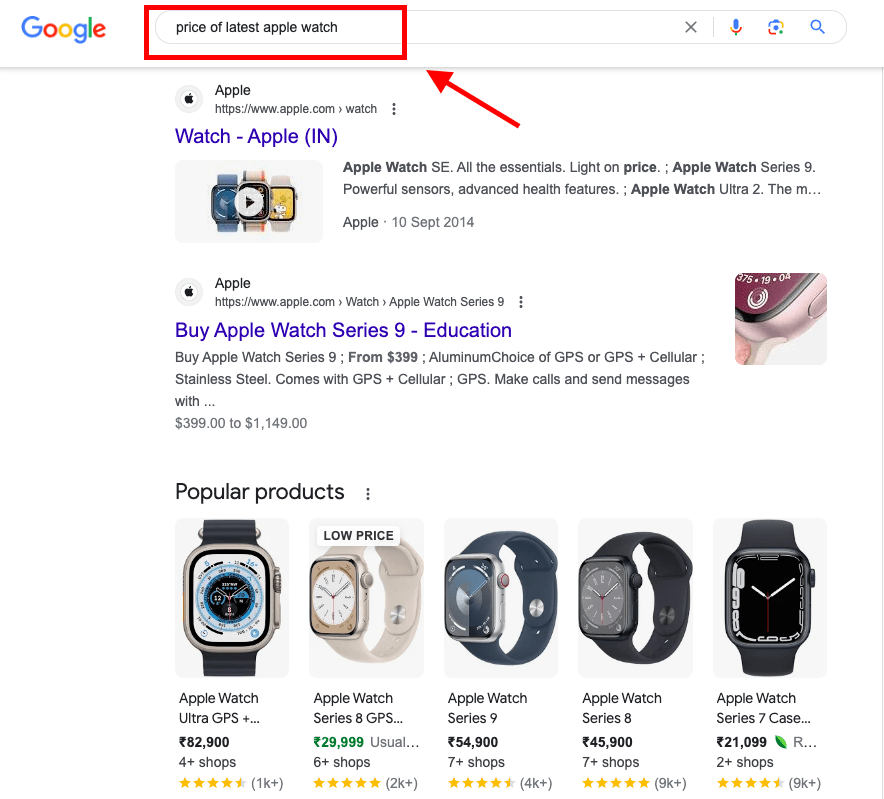
If you know which keywords are relevant to your business, you will be able to target them on your site. As a result, you can rank for those keywords on SERPs.
But wait.
It was this easy to rank a few years back. But not anymore!!
Today, if you want to see your site on the first page of search engine result pages, you must conduct keyword research correctly. Your keywords should neither be too difficult to rank for nor have too little monthly search volume. Therefore, you need to do thorough keyword research. Let us find out how.
How to Conduct Keyword Research?
Suppose you have the right keyword tools but don’t know how to find the keywords for your SEO campaign using them. Then, all your efforts will go to waste. So, to ensure your hard work pays off, go through the details of conducting keyword research below:
A) Know Your Audience Better
Understanding your audience is crucial for effective keyword research. It helps you:
- Know the search intent of your audience.
- Identify their pain points.
- Tailor your content to match their needs, interests, and search behaviors.
- Get valuable insights into your target audience’s needs.
To get keywords that will be effective in capturing the attention of your audience, you need to:
- Talk to your existing customers or audience.
- Collect feedback through surveys, emails, social media, or direct interactions.
- Ask about their preferences, pain points, and what they find valuable.
- Monitor the conversations happening on social platforms related to your industry or niche to understand their language and concerns.
B) Make a List of Words/Phrases Related to Your Business
If you are creating a website from scratch, you must first sit down and write the words or phrases related to your business. Think, identify, and research the word or phrase that represents your business.
You can also imagine yourself in your audience’s shoes. Then, consider what you would type when looking for your products or services. What keywords would you use to seek information on your products or consider buying them?
After completing the above exercises, compile a list of keywords representing your business.
C) Use Keyword Research Tools
Once you get a list of your potential keywords after talking to your audience and brainstorming keywords related to your business, you can search for those words using keyword research tools. If you do not have the budget and are looking for free tools, then you can use Google Keyword Planner to dig deeper into your keywords. Or go for SEO tools like AHRF, MOS, or SEMrush if there is no budget constraint.
You can use different metrics like search volume, keyword difficulty, search location, etc., to determine the keyword that will align closely with your products/services.
Need help in finding the right keywords for your business? Contact Knotsync
D) Employ Keywords in Your Content
Now that you have your keywords, build your content strategy around them. Remember that each page on your website should target one main primary keyword. If you carefully use keywords in your content, it will improve the chances of it being found in search engines.
But if you don’t, you will create content about things your target audience is not searching for.
Many website owners make that mistake, and it’s likely a big part of the reason why 96.55% of pages get no traffic from Google. Make sure you don’t repeat the same mistake.
Where to Use Researched Keywords on Your Website?
Use your researched keywords naturally in your blog post or landing page. Keep it as near to the top of the page as possible. Just ensure you are writing for actual people and not for Google alone. You can also place the researched keywords in:
1. The Page Title
If you can use the chosen keyword in your title, it will help with on-page SEO. However, use a variation if you can’t use it naturally in the title. It still sends out the right message. Something is better than nothing!
2. The Image Alt Text
Images and content go perfectly well together. Always use images in your content as they help explain your topic clearly and can better engage and inform your audience. Adding image alt text will improve your website’s accessibility, user experience, and SEO. Moreover, if you use your keywords in an image alt-tag, it will show up during image searches.
3. The Page URL
Make sure your target keyword appears in your page’s URL. It will help search engines know what your page is about. Moreover, it will also make your URL look neat and easy to recognize.
4. The H1, H2, and H3 Headings
You can rank for multiple keywords by adding them in your headings. Insert multiple important keywords in H2s. These headings divide your article into easily readable sections. When you use keywords in titles, it makes them relevant to your content. It gives your readers the basic summary of your blog and makes your content easy for search engines to understand.
Note: Heading 1s, or H1s, are set aside for the main title of the article. Do not use multiple H1s in your content; it can confuse Google. Stick to a single H1 as your article title and include your primary keyword.
Keyword Research Checklist for 2024
A keyword research checklist template can help you ensure you do everything to get the desired results. Further, you can use it to double-check to ensure you have done keyword research the right way. So, without wasting any more time, let’s check out the keyword research checklist to succeed in 2024.

1. Use Long Tail Keywords
Generally, long-tail keywords are very specific and contain three or more words. They match more closely to what a person would search when performing a search. Though long-tail keywords have low search volume, they have a high conversion rate as they clarify the searcher’s intention behind the search.
It means that if you don’t target long-tail keywords correctly, you minimize your chances of getting discovered by people who want to buy from you.
So, target long-tail keywords in your content and boost your site’s SEO. You can search for long-tail keywords by:
- Using SEO tools like SEMrush or KWFinder
- Utilizing Google’s People Also Ask section
- Typing in half your query in the search tab and see what Google suggests
- Looking at Google’s Related searches
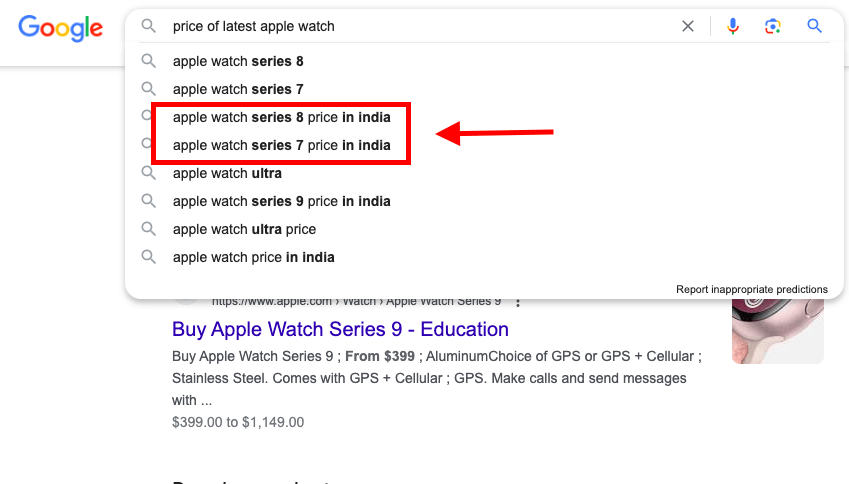
2. Select Keywords to Suit Your SEO or PPC Campaigns
Many people make the mistake of using the same keywords for SEO and their PPC campaign, which can significantly impact the results. If you use the wrong keywords for SEO, you won’t be able to rank for those keywords and attract traffic.
On the other hand, not targeting the right keywords for your PPC campaign will result in increased ad spending and lower conversion rates.
For your SEO campaign, utilize tools like Google Keyword Planner, SEMrush, Ahrefs, and Moz’s Keyword Explorer. Focus on relevance, search volume, competition, and user intent. Prioritize long-tail keywords, considering informational, navigational, and transactional intent.
For instance, to look for keywords to target a pest control business, we started with the word “pest control” and then used filters to get relevant results. We set:
- Volume from 1,001-10,000
- Keyword difficulty to possible (30-49%)
- Intent = informational

You can also consider the following metrics:
Search Volume Trends: Look for keywords with consistent or growing search volumes over time. Seasonal variations and changes in user behavior can impact search volumes, so consider these fluctuations when selecting keywords.
For example, the search trend for the keyword “commercial pest control” went down While the search volume for “residential pest control” stayed consistent with time. So, it’s better to include the keyword “residential pest control” in your SEO strategy. Moreover, it was easier to rank for this keyword, as seen in the images below.
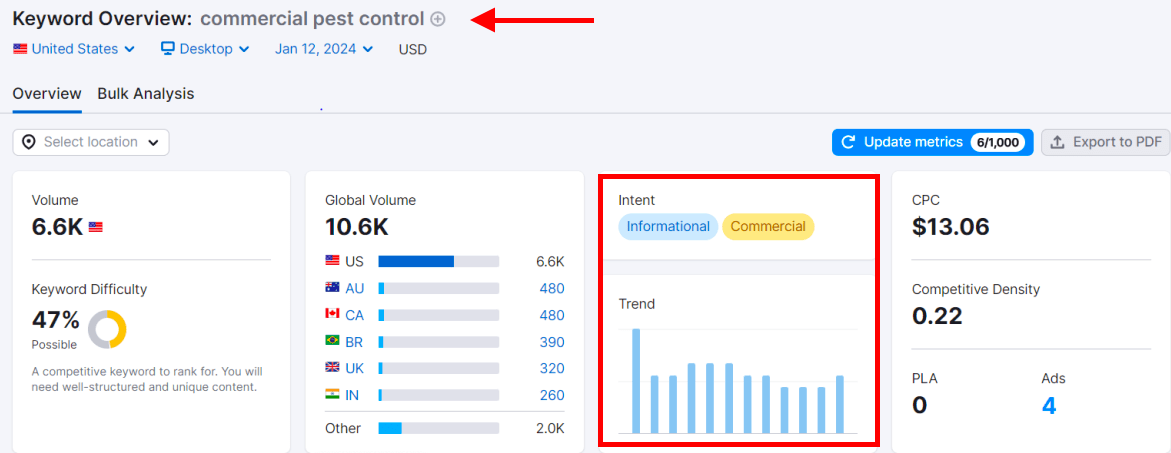
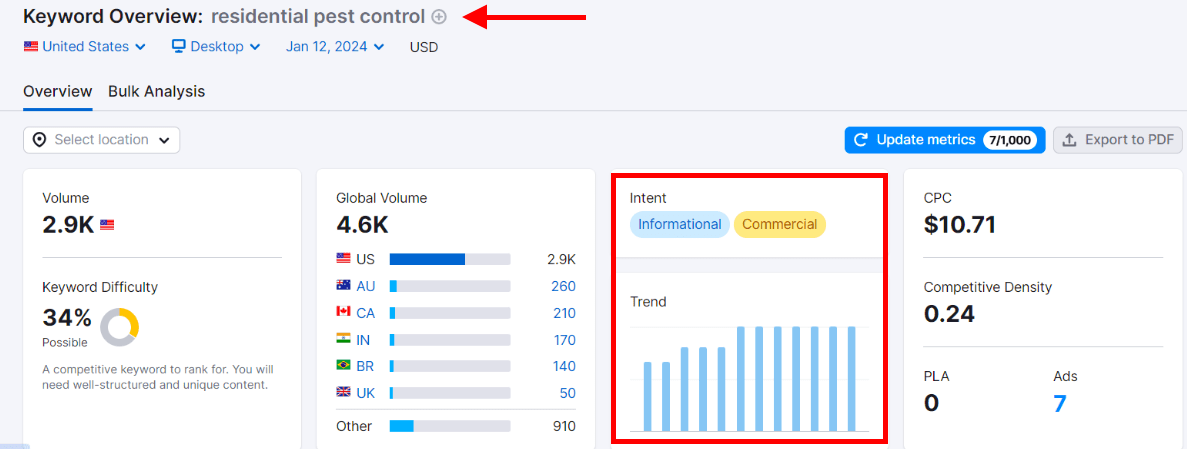
Keyword Difficulty: Tools like Moz’s Keyword Explorer or Ahrefs provide keyword difficulty scores. Aim for a balance between high search volume and manageable difficulty. Targeting long-tail keywords or niche phrases with lower difficulty can often be more effective than highly competitive terms.
In the example below, the keyword difficulty score on Moz’s Keyword Explorer for “home pest control” is 44. It means that one can easily rank for the said keyword.
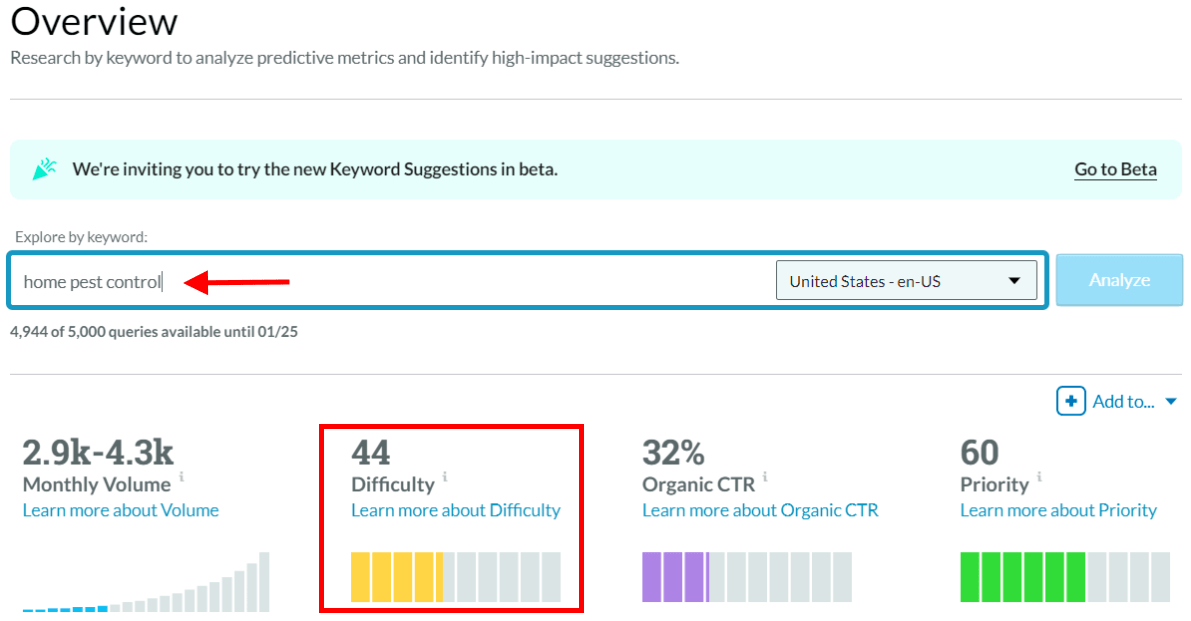
When researching keywords for your PPC campaign, employ Google Ads Keyword Planner, SpyFu, KeywordSpy, and SEMrush’s PPC Keyword Tool. Emphasize commercial intent, high-converting keywords, relevance to ad groups, and negative keyword identification.

The image above shows the competition for our keywords “pest control,” “residential pest control,” and “home pest control.” You can also add many filters to refine your search.
Make sure that you are considering the following metrics:
Cost-per-Click (CPC) and Estimated Bid: Use tools like Google Ads Keyword Planner or SEMrush to get CPC estimates and suggested bids for keywords to understand the potential cost associated with each keyword.
From the pictures below, it is clear that the keywords we chose for SEO are suitable for SEO campaigns but useless for PPC campaigns because they have very high CPC and keyword difficulty. So, choose keywords by balancing higher CPC with your budget to maximize ROI.
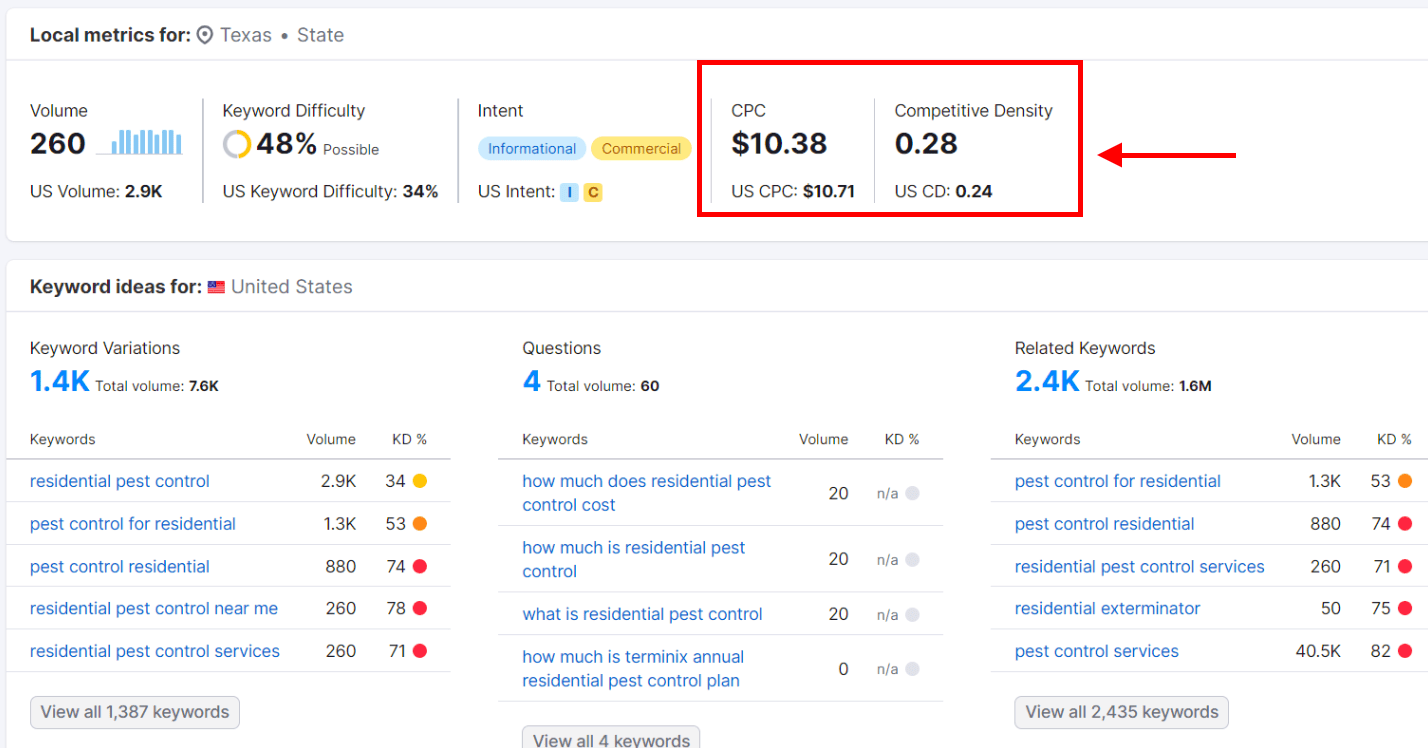
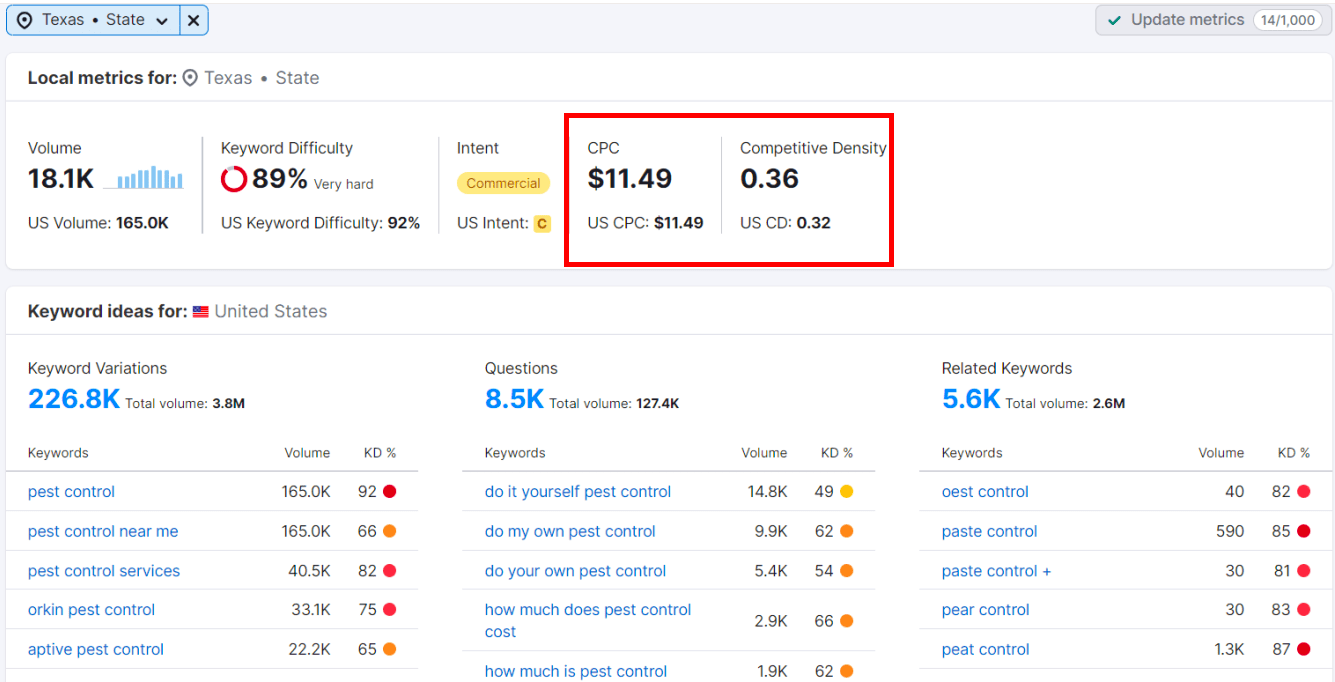
Ad Impression Share: This metric indicates how often your ads are displayed compared to the total available impressions. Track ad impression shares metrics within your PPC platform (e.g., Google Ads) to assess competitiveness. Then, increase impression share by optimizing your bidding strategy and improving keyword relevancy.
Keyword Relevance to Ad Copy: Ensure your chosen keywords align closely with your ad copy and landing page content. It will improve Quality Score and ad performance, potentially lowering CPC. Create ad groups with tightly themed keywords to improve relevance and increase click-through rates.
Historical Performance Data: Leverage historical performance data from your PPC platform or third-party tools. Analyze metrics like CTRs, conversion rates, and past campaign performance for similar keywords. Identify high-performing keywords based on historical data to guide your keyword selection process.
Want to go through this SEO checklist later? Download keyword research checklist pdf
3. Assess the Search Engine Results Pages (SERP)
Results on the top of the search engine result pages indicate that their content is liked by the audience and Google alike. So, assess the content on SERPs. It will help you discover what type of content makes it to the featured snippets and whether your target audience likes audio, visual, or written content.
Understanding SERP features helps tailor your content to target these features, enhancing visibility and click-through rates. Try tools like SEMrush or Moz. They track SERP features associated with specific keywords.
4. Use Related Keyword Suggestions
Explore related keyword suggestions provided by tools like SEMrush or even Google’s related searches. You can also try Google Keyword Planner’s keyword by relevance. These suggestions can uncover variations, synonyms, or related terms that users frequently search for, helping diversify your keyword strategy and content creation.
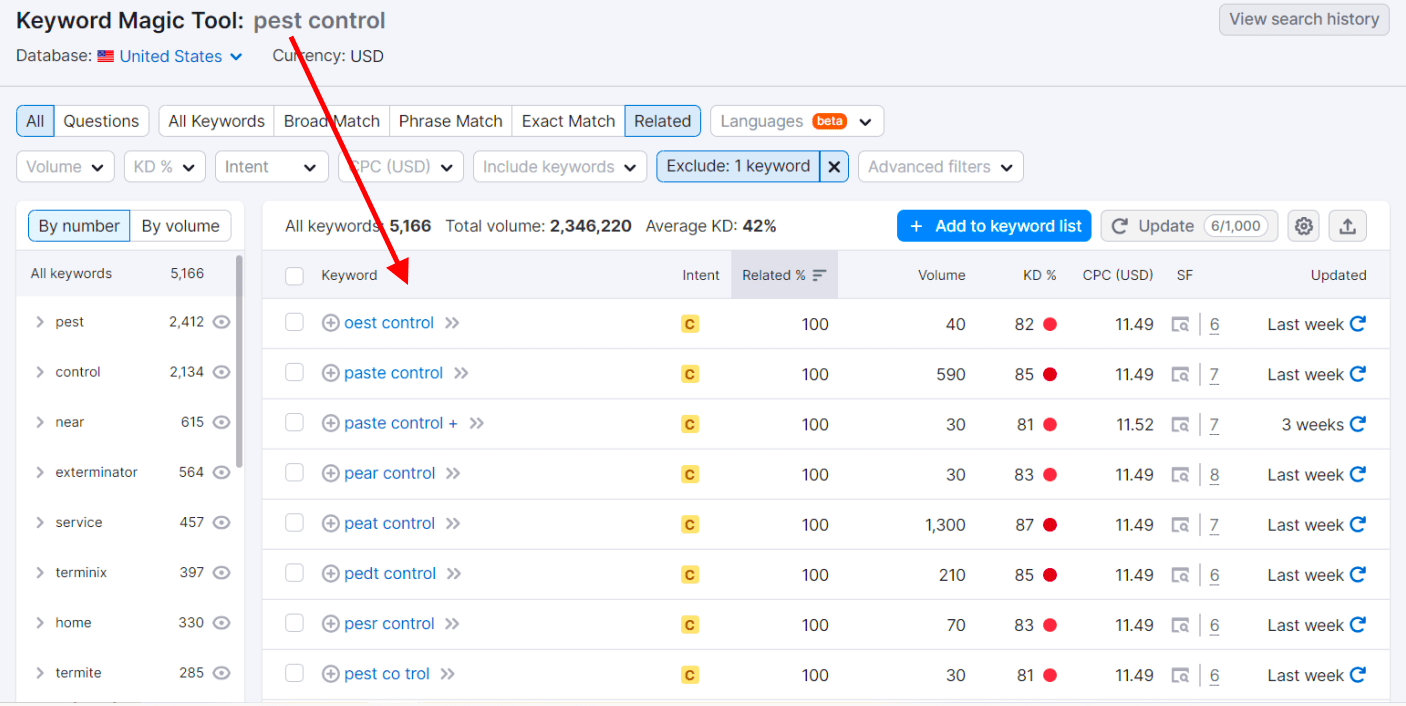
5. Pick Keywords Based on Your Audience’s Search Intent
When users type a query into a search engine, it shows their keyword intent. If you know why they’re searching for a particular keyword, you can create content that can satisfy their expectations and improve your search rankings. There are four that you can target, namely:
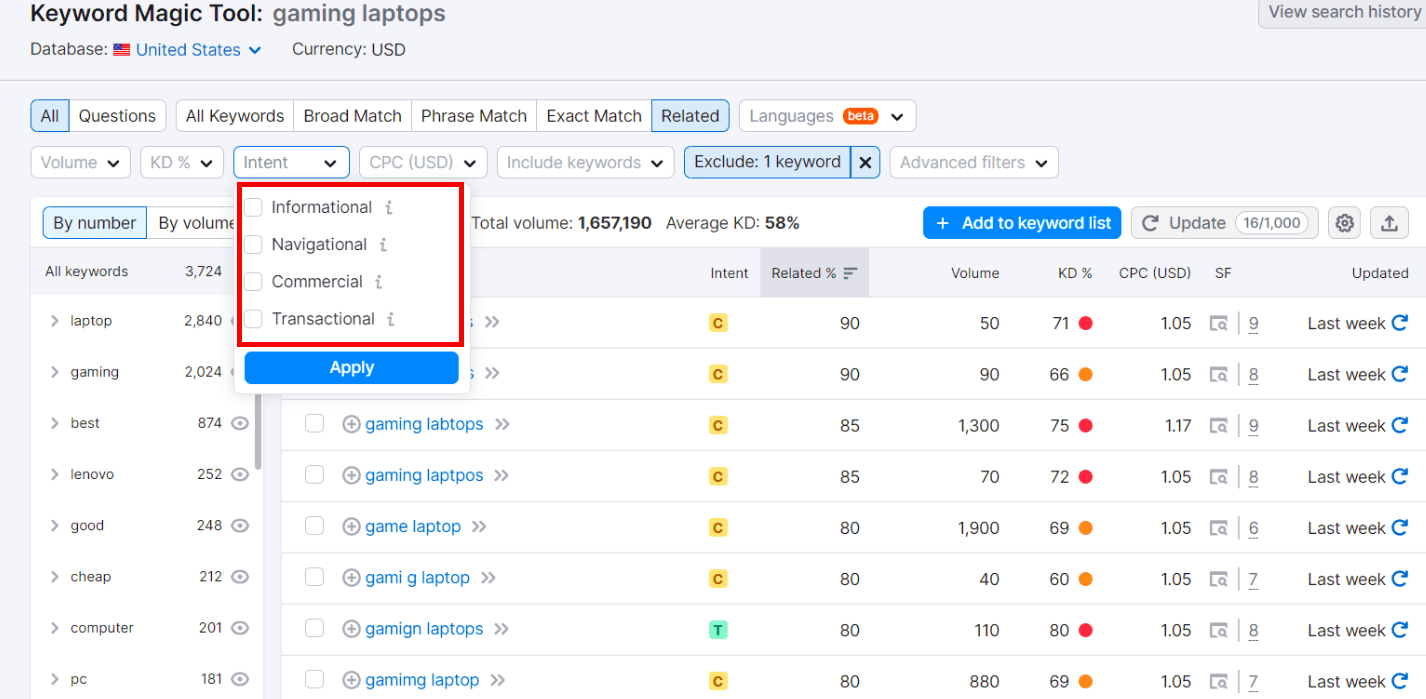
- Informational Search Intent: Users aim to find information, answers, or solutions to their queries without a specific intent for immediate action, such as learning, researching, or exploring a topic. Example: How to choose a laptop for graphic design.
- Navigational Search Intent: Users seek to navigate to a specific website or page, often by using brand names or terms related to the content they seek. Example: HP official laptop store.
- Commercial Search Intent: Users are interested in gathering information about products or services to make a purchase, but not necessarily immediately. Example: Best Gaming Laptops 2024 reviews.
- Transactional Search Intent: Users intend to perform a specific transaction, such as purchasing, signing up for a service, or completing an online action. Example: Buy Dell Inspiron 15 laptop online
You will only be able to see good results if you optimize your content using keywords that depend on the search intent of your target audience.
Look for keywords depending on the search intent of your users. Then, use those keywords in your content according to the needs of your audience.
For example, you can add commercial and transactional keywords to the landing page where you are providing the offers. Or strategically place your information keywords in your blogs.
The better the keywords are placed according to the user’s search intent, the higher the chances readers will spend more time on your website. And more time spent on your website will tell search engines like Google that you are an authority in your field.
How to Identify Search Intent?
If you don’t understand the intent of the content that Google is ranking, rely only on query volume, and ignore search intent, your content won’t align with the user’s intent. As a result, you most likely won’t rank for your keyword. Even if you somehow end up ranking on SERPs, your page will not match the searchers’ intent, leading to a poor experience and increasing your bounce rate.
The easiest way to identify search intent is to look at the top 10 ranking pages for your target keyword. Most of the time, you’ll notice that all or most pages follow the same content format and type. So, analyze the pages that rank for your target keywords and ensure your page’s content aligns with the searcher’s intent.
For example, looking at the top 3 results for “how to tie a tie,” the top three results have similar kinds of informational content, i.e., video content. So, create a YouTube video on how to tie a tie.
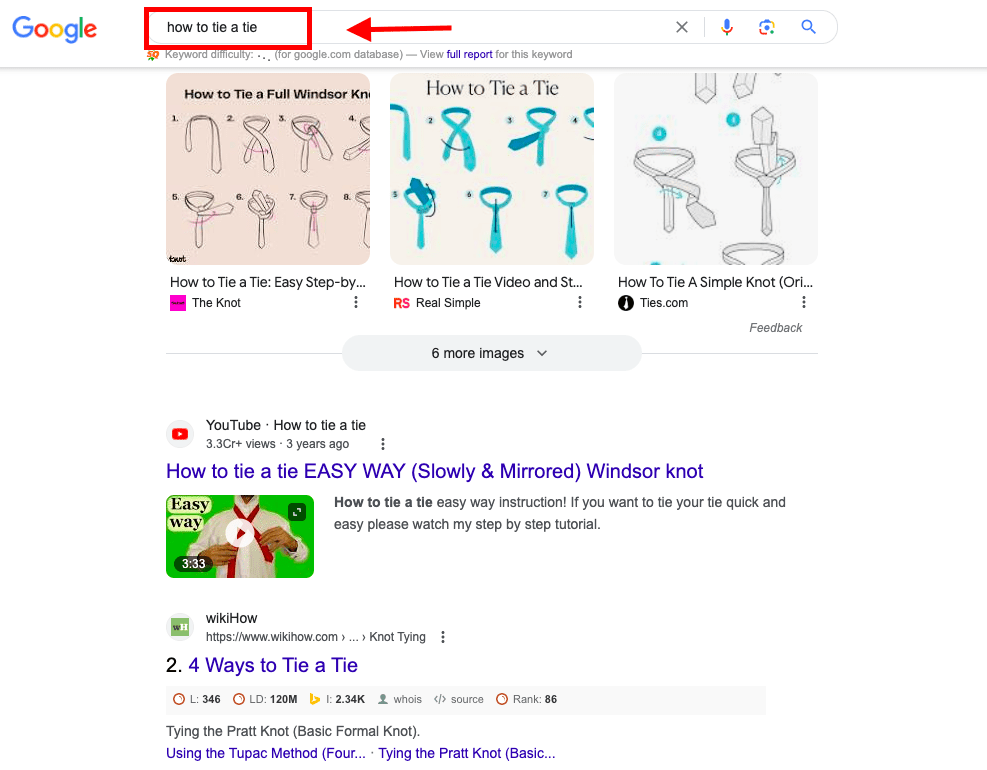
Unless you do not match this search intent with the content your target audience wants to consume (in this case, video content), you won’t be able to satisfy their needs and strike a chord with your audience. If you do not have the resources to create a YouTube video, you better focus on other variations of this keyword.
Tip: If you can’t match what searchers want, don’t go after that keyword.
6. Strike a Balance Between Keyword Difficulty and Search Volume
Typical advice that many marketers would have given you, especially if you’re just starting your new website, is to target keywords having low difficulty. Low keyword difficulty means the competition level for that specific keyword is low, implying it is easier to rank for that keyword.
While it is true that keyword difficulty plays a part in deciding if your keyword ranks or not, what you need to focus on is search volume as well. Focusing on keywords that are easy to rank and have less search volume will be useless.
So, choose keywords that are easy to rank and have a considerable number of monthly searches. The number of searches may differ depending on your niche. Aim for keywords with low to medium difficulty, having moderate to high search volume.
For example, you’re running a local plumbing business in San Antonio, Texas. Then, you can target keywords with a difficulty of less than 30 and a search volume of more than 100 searches per month. By using SemRush’s Keyword Magic Tool, you can assess keyword difficulty and search volume and strike a balance between the two.
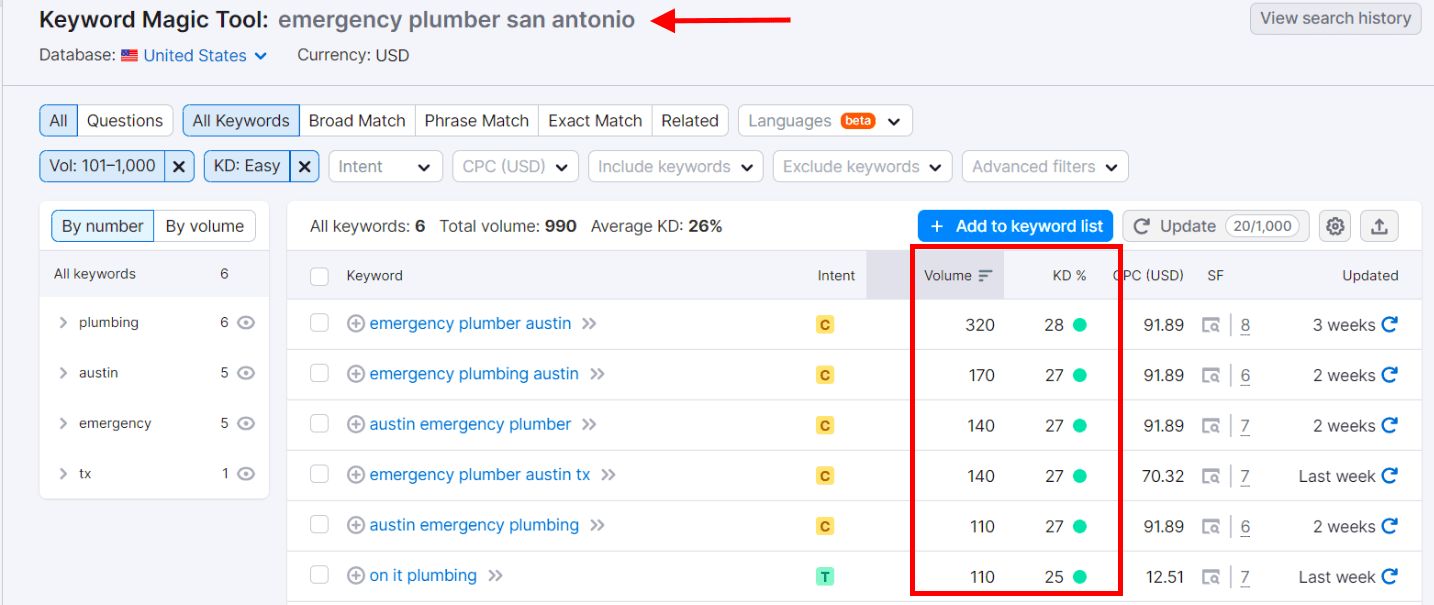
As it can be seen in keyword research conducted above, you can start by targeting the following keywords:
- Emergency plumber Austin
- Emergency plumbing Austin
- Austin emergency plumber
- Emergency plumber Austin Tx
All these keywords had 100+ searches per month, and it was easier to rank them. Once you start ranking, you can then go for more competitive keywords.
7. Target Location-based Keywords (If you sell products in a particular location)
Most people do not consider their target location when doing keyword research. But one needs to remember that search results vary greatly depending on the location, and so do the keywords.
If you are conducting keyword research for a client who runs a local business, choose their target location in the SEO tool you use to conduct the research. It will provide you with location-specific search queries that your target audience uses to look for products or services similar to your client’s products or services.
For instance, your client has a winery in Florence, Italy. So, you can start with geo-targeted keywords like “winery in Florence” and set the location to Italy.
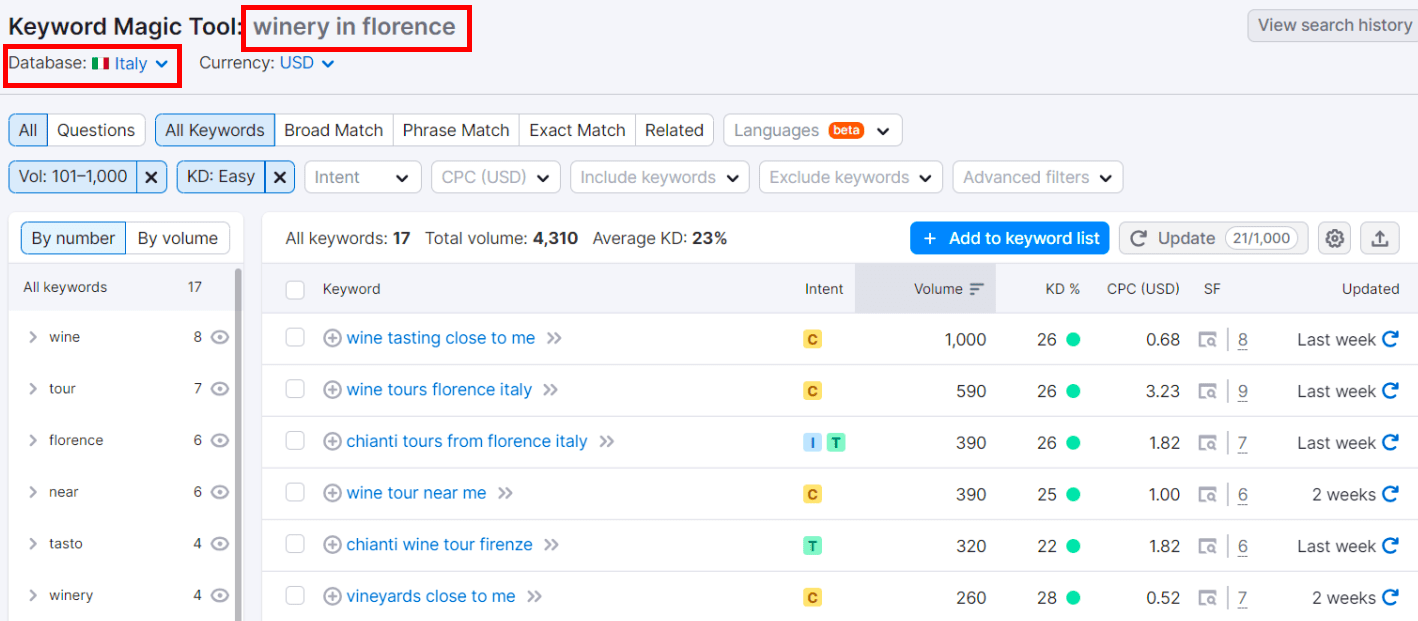
Once you enter the search query and hit search, you will get keywords like wine tasting close to me, wine tours Florence, Italy, best wineries near me, etc. You can use SEO tools like SemRush and Google Keyword Planner for keyword research.
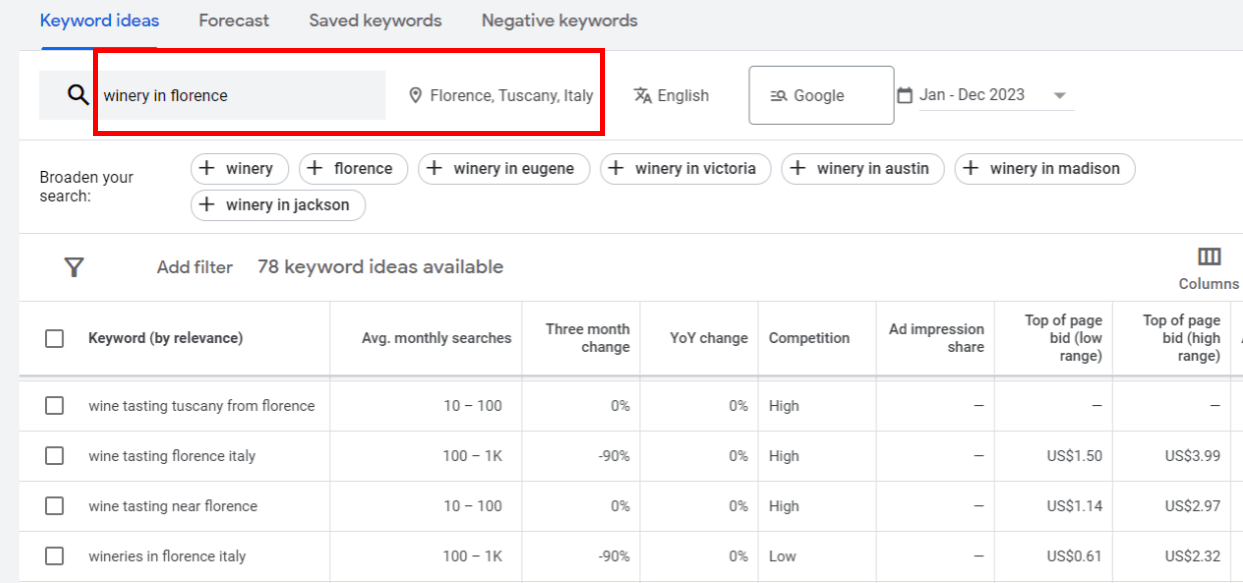
8. Use Conversational Keywords
Recently, many users have used voice search when searching queries in the search engine. Therefore, it is essential to optimize your content for voice search. So, along with long tail keywords, also check for conversational keywords.
For example, if you live in Texas, you can search for the conversational keyword “Where can I buy a smartphone nearby in Texas ” in Google search and see other related keywords in related searches.
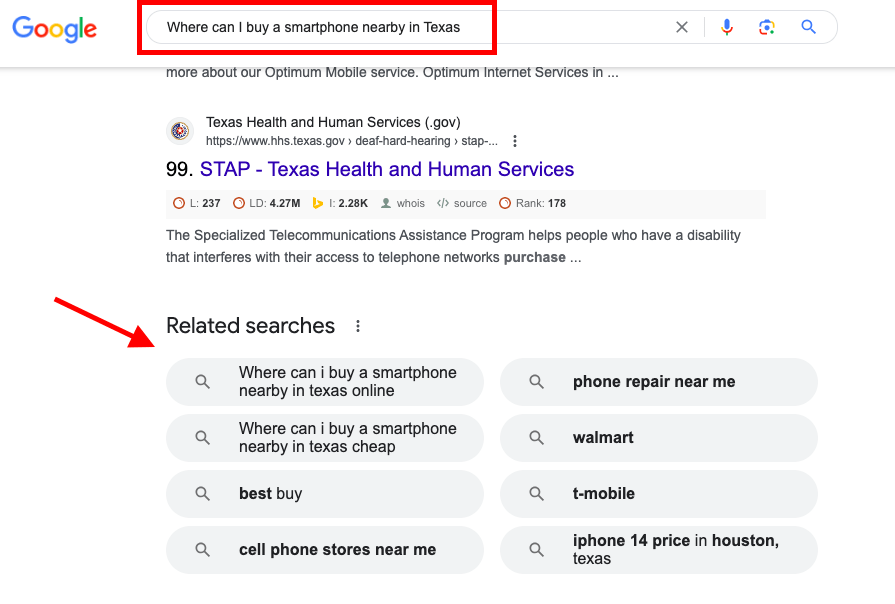
Once you have your conversational keywords, answer these questions directly and concisely in your content. You can also make these conversational keywords headings as well.
Optimizing your website content for voice searches will ensure that you are changing your strategies according to the changing needs of your target audience. It will help you keep up with the changing times, satisfying their needs.
9. Perform Keyword Gap Analysis
To get more keywords related to your business:
- Perform competitor research.
- Run your own domain through the SEMrush Domain Overview tool. You will quickly identify competitors competing in the same space as you are and see how your visibility compares.
- Look for the keywords your competitors are ranking for, but your site isn’t.
You can also use AHREF’s Content Gap tool to see the keywords that your competitors are missing out on.
It will give you an idea about the keywords that are working well for your competitors in your niche. Pay special attention to keywords that are bringing most of their organic traffic. Your gap analysis can also help you spot opportunities where you can rank for valuable keywords that your competitors are not targeting.
Conclusion
It is not humanly possible to include everything important for SEO in just one checklist. However, we have tried to unravel some valuable keyword research secrets. If you follow the ultimate keyword research checklist with examples for 2024 mentioned above, you will see success from your SEO efforts and will be well on your way to higher rankings on SERPs.
Remember, you need to revisit your keyword research checklist occasionally to ensure that all the content you publish aligns with the best SEO practices. You can also hire SEO specialists from the best SEO provider for the best results.




